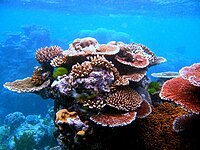
Photo from wikipedia
Motile cryptofauna inhabiting coral reefs are complex assemblages that utilize the space available among dead coral stands and the surrounding coral rubble substrate. They comprise a group of organisms largely… Click to show full abstract
Motile cryptofauna inhabiting coral reefs are complex assemblages that utilize the space available among dead coral stands and the surrounding coral rubble substrate. They comprise a group of organisms largely overlooked in biodiversity estimates because they are hard to collect and identify, and their collection causes disturbance that is unsustainable in light of widespread reef degradation. Artificial substrate units (ASUs) provide a better sampling alternative and have the potential to enhance biodiversity estimates. The present study examines the effectiveness of ASUs made with defaunated coral rubble to estimate the diversity of motile cryptic crustaceans in the back-reef zone of the Puerto Morelos Reef National Park, Mexico. Species richness, Simpson’s diversity index, Shannon–Wiener index and the composition of assemblages were compared between ASUs and samples from the surrounding coral rubble substrate. A combined total of 2,740 specimens of 178 different species, belonging to five orders of Crustacea (Amphipoda, Cumacea, Isopoda, Tanaidacea and Decapoda) were collected. Species richness was higher in the surrounding coral rubble and Shannon–Wiener and Simpson indexes were higher in ASUs. Species composition differed between methods, with only 71 species being shared among sampling methods. Decapoda was more speciose in ASUs and Peracarids in the surrounding coral rubble. Combining the use of ASUs with surrounding rubble provided a better inventory of motile cryptic crustacean biodiversity, as 65% of the species were represented by one or two specimens.
Journal Title: PeerJ
Year Published: 2020
Link to full text (if available)
Share on Social Media: Sign Up to like & get
recommendations!